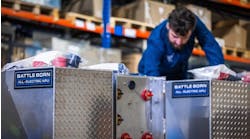Editor's note: This is a continuation of a story posted on Monday. Read part 1.
For fleets facing more pressure than ever to meet customers’ needs, “we just can’t afford to have a service event. It just ruins everything,” said Dave Williams, a senior vice president with truckload carrier Knight-Swift Transportation.
Likewise, when it comes to retaining drivers, “there’s nothing more important today… than uptime,” he added. “When we have a downtime event, it means more to the driver because it takes out of their paycheck.”
Williams blamed the lack of flexibility with hours-of-service rules for adding pressure, since drivers currently cannot stop their daily clock once it starts. In the past, they could break up their days with time in the sleeper berth.
While an unplanned downtime event with a tractor-trailer is problematic on its own, it really is only a piece of the overall headache. Jason Plumlee, director of maintenance for less-than-truckload carrier Saia Inc., said that “downtime begins when we drive onto a dealer’s yard,” and that the fleet is starting to better leverage technology to save time in these situations.
Tony Wahl, assistant director of equipment purchasing for truckload carrier Werner Enterprises, noted that beyond the time lost getting into a dealership, decisions need to be made about where to drop the loaded trailer and what to do with the stranded driver.
In response, equipment manufacturers have been rolling out new technology systems to create more real-time visibility on repairs and speed online ordering of parts. Combined with advances in predictive maintenance and remote over-the-air engine updates, fleets are starting to gain access to what Williams called “actionable” data to make better equipment and personnel decisions with a higher level of independence.
Building relationships
An improved relationship with dealers could play a role in helping fleets achieve a “consultative relationship (with shippers) to help them operate more efficiently and to make doing business as easy and frictionless as possible,” said Bob Biesterfeld, CEO of third-party logistics and transportation services provider C .H . Robinson Worldwide.
As part of the 2019 State of Logistics report, Biesterfeld explained that carriers require visibility into asset locations, connectivity to various electronic systems, and early access to freight in order to optimize routing and equipment utilization in real time.
With so many telematics options available, “no singular technology will address every need or provide the same benefit to every fleet,” Susan Beardslee, principal analyst at ABI Research, explained.
A survey from ABI found more than 60% of fleets are planning to increase their investments in technology as a new decade dawned.
“To succeed, they will need to develop greater knowledge of the fundamentals at a minimum and form trusted relationships with external experts,” Beardslee said. “The ability to integrate and scale are major considerations, as well as taking a long-term perspective on fleet needs as well as provider capabilities and viability.”
That message was echoed in a benchmarking report on telematics by Sid Nair, senior director of transport and compliance with Teletrac Navman.
“Using data effectively is the key to making your fleet work smarter, not harder, but managers can only reap these benefits if they look beyond using technology strictly for compliance and commit to using data to inform important business decisions—ones that can boost productivity and minimize expenses,” Nair said.
While a majority of companies are using telematics for location and speed, far fewer measure metrics like idling and fuel usage that could boost their bottom lines.
At the NACV show, there were signs that is beginning to change. Numerous suppliers showed next-generation monitoring systems for trailers, tire pressure and other critical data.
“Our customers need simple and powerful access to manage their fleet and temperature down to the smallest detail,” said Carl Breczinski, truck product manager for Thermo King North America.
It is the fleets best able to leverage the information that will rise to the top over the next 10 years.
Continue to Part 3: How much electrification progress can be expected by the end of the decade?



